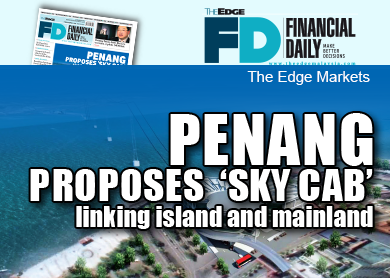
KUALA LUMPUR: The Penang government is in the final stages of exploration with Penang Sentral Sdn Bhd (PSSB) to build a 3.66km cable car service linking the mainland and island in the next three years. PSSB is a wholly-owned subsidiary of Malaysian Resources Corp Bhd (MRCB).
Chief Minister Lim Guan Eng told The Edge Financial Daily that the proposal for the “Penang Sky Cab” is an additional project to the RM2 billion Penang Sentral transport hub that PSSB is currently carrying out in Butterworth.
It is a new project not featured in the RM27 billion Penang Transport Master Plan revealed in 2012.
“We proposed to PSSB ... it is a concrete proposal and PSSB is keen on it though it is not part of the overall Penang Sentral transport hub project. However, it would enhance their project and increase connectivity for users.
“We realised that there was no convenient crossing for pedestrians apart from the two Penang Bridges located in the central and southern region of the state. In the northern region, there is only the ferry service.
“If everything goes as planned, including the technical specification compliance, we expect it to be completed by 2018,” Guan Eng told a press conference to announce the project yesterday, adding that the study by PSSB began last year and is almost completed.
Asked about the disruption to the sea lanes in Penang Port, Guan Eng said Penang Port Commission (PPC), which regulates the port, has “in principle” no objection to the cable car project.
“Our exploration would not be at this advanced stage if we had not got PPC’s view. You must remember that the Penang Sentral project is also part of the Northern Corridor Implementation Authority. So this is seen as a joint effort between the state and federal agencies,” he said.
The estimated cost of the project was not revealed at the press conference because PSSB, jointly owned by MRCB (fundamental: 0.60; valuation: 0.60) and Pelaburan Hartanah at a 49:51 ratio, is still working out the details, the chief minister said.
Pelaburan Hartanah is a real estate investment holding company and a wholly-owned subsidiary of Yayasan Amanah Hartanah Bumiputera.
Guan Eng expressed confidence that PSSB would be able to recover its cost as the Penang Sky Cab project will be based on a standalone operational basis.
“The cable car will also benefit from the unique fivefold public transport feature comprising water, rail, taxi, bus and cable car that is attractive to users,” Guan Eng said.
The Penang Sentral project, which has taken off after a seven-year delay, will feature a business hotel and shopping mall, apart from the public transport hub where bus, taxi and rail networks will converge in one spot.
“Out of two options, we chose the second one because the landing point on the island would be sited on state land instead of the heritage clan jetties which were part of the first option,” he said.
Guan Eng said the cable car service will link Butterworth on the mainland and Gat Lebuh Noordin on the island with 40 gondolas plying the North Channel on a 15-minute journey.
“About 10 passengers ... would be able to travel on each gondola every 15 minutes. It will have a 360° view and an observatory tower in the middle of the channel,” he said.
PSSB representative Shireen Iqbal said the Penang Sky Cab’s main objective is to improve tourism in the state while championing green technology and providing an alternative passage for pedestrians to cross the channel.
“The service will provide easy, convenient and frequent travel for passengers who would also enjoy the services provided at the transport hub at Penang Sentral.
“They can choose to travel by using the Rapid Penang buses or KTM Bhd trains to other parts of the state and country, or enjoy the day at the shopping mall or stay over at the hotel there,” she said.
Shireen added that there would be eight or nine towers about 90m above sea level with 50m navigational clearance width in between for vessels to pass through.

This article first appeared in The Edge Financial Daily, on April 16, 2015.